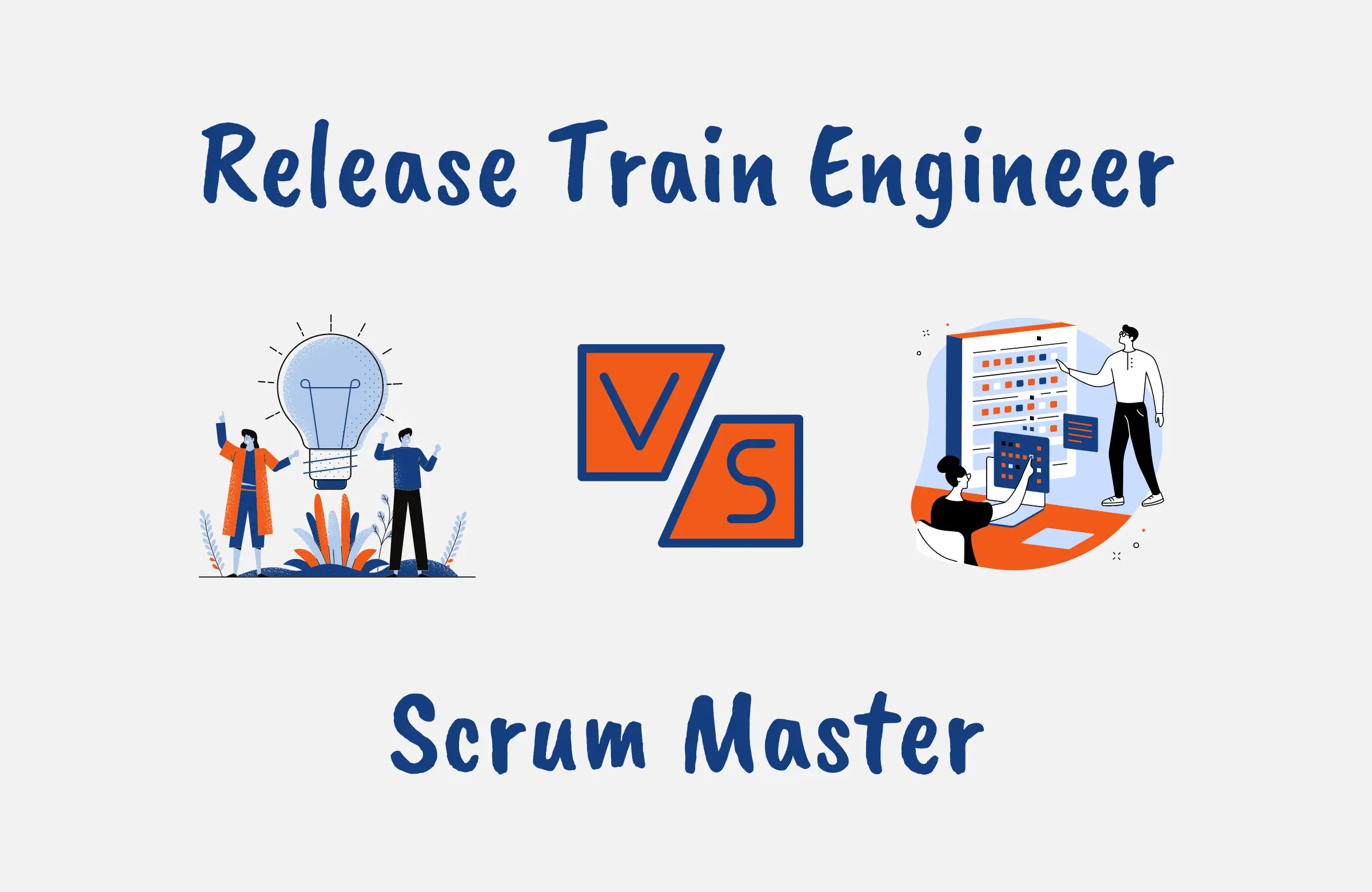If you are an Agile practitioner or enthusiast, you may be familiar with the Release Train Engineer and Scrum Master roles.
They both play a key part in Agile development as well as the Scaled Agile Framework (SAFe) serving as facilitators and coaches for Agile teams and Agile Release Trains (ARTs).
Under the banner of servant leadership, they foster an environment of trust and collaboration, driving continuous improvement and predictability in delivery albeit in different capacities. The question is who does what?
In this article, we compare the Release Train Engineer vs Scrum Master roles in-depth, focusing on how they differ in their responsibilities and contributions to teams, Program Increments (PIs), and overall project goals.
We’ll also cover steps to take if you’re looking to transition from a Scrum Master to a Release Train Engineer.
Difference Between Release Train Engineer (RTE) and Scrum Master
The main difference between a Release Train Engineer (RTE) and a Scrum Master is that the RTE enables multiple teams to work together on an Agile Release Train (ART) and achieve Program Increment (PI) goals, while the Scrum Master focuses on one team’s efficiency and performance.
What is the Role of the Release Train Engineer (RTE) in SAFe?
The Release Train Engineer acts as the servant leader who guides the Agile Release Train (ART) in the Scaled Agile Framework (SAFe).
The RTE is responsible for steering the ART towards achieving its mission and goals, and ensuring that all the teams on the train work together efficiently and effectively.
As the chief Scrum Master in SAFe, they facilitate Program Increment (PI) planning, manage risks, and help resolve impediments to drive predictability in the delivery of value.
By fostering a culture of trust and collaboration, the RTE encourages continuous improvement in processes and practices.
What is the Role of the Scrum Master in SAFe?
The Scrum Master is focused on a single Agile team within the Agile Release Train (ART), helping them adhere to Scrum practices and principles to achieve their specific goals unlike the Release Train Engineer (RTE) who oversees the entire ART.
They facilitate team events, including Sprint Planning and reviews, ensuring transparency and predictability in the team’s output.
It’s the role of the Scrum Master to create an environment of trust and collaboration, removing impediments that hinder the team’s progress and fostering continuous improvement in team performance.
In the context of Program Increment (PI) planning, the Scrum Master works closely with the RTE to align their team’s objectives with the broader goals of the ART by driving team agility and helping the team deliver value consistently.

Release Train Engineer vs Scrum Master Comparison
As earlier iterated, the Release Train Engineer (RTE) and the Scrum Master both serve as servant leaders within the Scaled Agile Framework (SAFe), with each bringing a unique contribution to the Agile Release Train (ART).
However, their roles exhibit significant differences in certain areas including:
1. Scope of Influence
The RTE operates at the program level, guiding the entire ART, which could comprise multiple teams. They ensure that the train stays on track and that all teams work collaboratively towards achieving common goals.
On the other hand, the Scrum Master operates at the team level, focusing on a single agile team within the ART to ensure that the team adheres to Scrum practices and principles and that the team members work effectively together.
2. Responsibilities
The RTE’s responsibilities are broad and encompass facilitating Program Increment (PI) planning and execution, managing and mitigating risks, and resolving impediments that could impact the entire train or multiple teams.
They are also responsible for communicating with stakeholders and ensuring alignment with the organization’s strategic objectives.
Conversely, the Scrum Master’s responsibilities are more focused on their team facilitating team-level events such as daily stand-ups, Sprint Planning, and Sprint Retrospectives to ensure the team meets its goals which are a subset of the overall ART goal.
3. Interaction with the ART
The RTE needs to maintain a big-picture view of the ART, understanding how each team’s work contributes to the overall objectives to ensure that the teams are synchronized and that dependencies are managed effectively.
The Scrum Master, on the other hand, focuses on their team’s interaction with the ART to ensure that their team’s work aligns with the ART’s objectives and that their team effectively collaborates with other teams when necessary.
4. Culture Building
Both the RTE and the Scrum Master foster a culture of trust and collaboration. However, the RTE does this at a larger scale, promoting predictability and a culture of shared responsibility across the entire ART.
The Scrum Master nurtures these values within their team, promoting transparency, respect, and a commitment to delivering value consistently.
5. Level of Decision-Making
The RTE often participates in higher-level decision-making processes that impact the entire Agile Release Train (ART) by working with other RTEs, Solution Train Engineers (STEs), and organizational leaders on strategic decisions and initiatives.
In contrast, the Scrum Master is involved in team-level decision-making, empowering team members to make decisions and fostering a self-organizing team environment.
6. Conflict Resolution
Both roles engage in conflict resolution, but the nature of conflicts they handle can differ. The RTE typically resolves conflicts that span across multiple teams or the entire train, such as resource allocation or prioritization issues.
The Scrum Master deals with conflicts within their specific team, such as interpersonal issues or disagreements over task assignments.
7. Coaching and Mentoring
While both roles involve elements of coaching, the RTE often mentors Scrum Masters and Product Owners, helping them improve their skills and understanding of SAFe principles.
The Scrum Master, on the other hand, coaches their team members to improve their understanding and application of Scrum and Agile practices.
8. Stakeholder Management
The RTE communicates with a broader range of stakeholders, including executives, customers, and suppliers. They ensure visibility and alignment at the program level.
The Scrum Master, however, primarily interfaces with the Product Owner, team members, and occasionally with other Scrum Masters and teams.
Release Train Engineer Responsibilities
The responsibilities of a Release Train Engineer (RTE) are wide-ranging, encompassing aspects of facilitation, coordination, and servant leadership requiring them to serve both the teams on the ART and the larger organization.
Their core responsibilities include:
1. Program Increment (PI) Facilitation
One of the primary responsibilities of the RTE is to facilitate the PI planning events and ensure that all teams on the ART align their objectives with the broader organizational goals.
They also coordinate with stakeholders to define the vision and roadmap for future PIs, driving predictability in the ART’s output.
2. Risk Management
The RTE identifies and manages risks that could impact the ART’s ability to deliver value working closely with teams and stakeholders to devise strategies for risk mitigation to ensure the successful execution of the PI.
3. Impediment Resolution
The RTE actively addresses impediments that could affect multiple teams or the entire train, often collaborating with Scrum Masters who manage team-level obstacles. This role in removing roadblocks is pivotal in maintaining the flow of value through the ART.
4. Communication and Alignment
The RTE ensures effective communication across the ART and with stakeholders. They align all teams around a common mission and vision, fostering an environment of trust and collaboration.
5. Continuous Improvement
As a servant leader, the RTE fosters a culture of continuous improvement. They facilitate regular Inspect and Adapt (I&A) workshops, helping the ART to reflect on its performance and identify improvement opportunities.
6. Coaching and Mentoring
The RTE often mentors Scrum Masters and other team members, helping them to enhance their understanding of SAFe and improve their skills.
Scrum Master Responsibilities
The responsibilities of the Scrum Master in SAFe are focused on a specific team within the Agile Release Train (ART) and center around facilitation, coaching, fostering a productive team environment, and ensuring that the team remains productive, engaged, and aligned with the ART’s objectives.
The core responsibilities include:
1. Facilitation
The Scrum Master facilitates various Scrum events such as daily stand-ups, Sprint Planning, Sprint Reviews, and Retrospectives. They ensure that these events happen within the timebox and provide value to the team.
2. Impediment Resolution
One of the Scrum Master’s key responsibilities is to remove team-level impediments by working closely with the team and the Release Train Engineer (RTE) to identify and address impediments that hinder the team’s progress.
3. Coaching
The Scrum Master coaches the team on Scrum and Agile practices, helping them enhance their understanding of these methodologies and their commitment to continuous improvement.
4. Team Dynamics
As a servant leader, the Scrum Master fosters a positive team environment. They work to build trust and collaboration within the team, ensuring that all team members feel valued and heard.
5. Alignment
The Scrum Master helps the team align its work with the goals of the Program Increment (PI) and the broader objectives of the ART. They ensure that the team’s efforts contribute effectively to the overall mission of the ART.
6. Predictability
By helping the team adhere to Scrum practices, meet their commitments, and continuously improve, the Scrum Master enhances the team’s ability to deliver value predictably.

Release Train Engineer Skills
The Release Train Engineer (RTE) must possess a diverse array of skills to effectively steer the Agile Release Train (ART) and align teams towards common goals. These include:
1. Leadership
As a servant leader, the RTE must inspire, empower, and facilitate teams to achieve their objectives. They must promote an environment of trust and collaboration, fostering a sense of shared responsibility across the ART.
2. Knowledge of SAFe and Agile
A deep understanding of SAFe principles and Agile methodologies is essential. The RTE must comprehend the intricacies of the Program Increment (PI), and how each team’s efforts contribute to the overall mission of the ART.
3. Communication
Effective communication skills are a must. The RTE needs to ensure transparent and open communication across the ART and with external stakeholders.
4. Problem-Solving
The RTE must be adept at identifying and overcoming obstacles that could impact multiple teams or the entire train. This requires strong analytical and problem-solving skills.
5. Facilitation
The RTE should possess strong facilitation skills to efficiently lead PI planning events, sync meetings, and Inspect and Adapt (I&A) workshops.
6. Continuous Improvement Mindset
A commitment to improvement is vital. The RTE should constantly seek ways to enhance the ART’s performance and predictability.
Scrum Master Skills
A successful Scrum Master combines a deep understanding of Scrum and Agile with exceptional leadership, communication, problem-solving, and facilitation skills to guide their team towards success within the SAFe environment.
1. Scrum and Agile Expertise
A profound understanding of Scrum principles and Agile methodologies is crucial. The Scrum Master should guide the team effectively through each Program Increment (PI) within the ART.
2. Servant Leadership
As a servant leader, the Scrum Master must cultivate an environment of trust and collaboration. They need to support and empower their team, helping each member to contribute optimally to the team’s objectives.
3. Communication
Excellent communication skills are essential. The Scrum Master facilitates clear and open communication within the team and liaises with the Release Train Engineer (RTE) and other stakeholders as needed.
4. Problem-Solving
The Scrum Master should be adept at identifying and resolving team-level impediments. This requires strong analytical and problem-solving capabilities.
5. Facilitation
The Scrum Master needs to effectively facilitate Scrum events, ensuring they add value to the team’s work and contribute to its predictability.
6. Continuous Improvement Mindset
A focus on improvement is key. The Scrum Master should foster a culture of continuous learning and improvement within the team, driving better performance over time.

Release Train Engineer vs Scrum Master Salary
Understandably, salary is an important consideration when comparing job roles. So let’s compare the salary of a Release Train Engineer and a Scrum Master.
Release Train Engineer Salary
The salary of a Release Train Engineer (RTE) varies greatly based on factors such as experience, location, and the size of the Agile Release Train (ART) they manage within the Scaled Agile Framework (SAFe).
Using the US as a study, according to Indeed as of January 2024, the average base salary of a Release Train Engineer in the US is $104,110 per year.
This can range from $157,312 to $111,259 per year depending on the high level of responsibility that comes with the role, and the organization.
Scrum Master Salary
Similarly, a Scrum Master’s salary is based on a variety of factors including experience, location, and the size of the teams they manage within the Agile Release Train (ART).
Payscale reports the average salary of a Scrum Master in the US as $193,878.

How to Transition from Scrum Master to Release Train Engineer
For a Scrum Master looking to become a Release Train Engineer (RTE), the transitioning requires not only a broadening of skillsets but also a shift in perspective.
Here are some steps to facilitate this transition:
- Deepen Your Understanding of SAFe: Build on your knowledge as a Scrum Master by studying the wider SAFe principles. Understanding how multiple teams work together within an Agile Release Train (ART) is crucial for an RTE.
- Expand Your Leadership Skills: As an RTE, your role extends from servant leadership within a team to being a servant leader for an entire train. Enhancing your skills in fostering trust, collaboration, and an environment open to improvement will be pivotal.
- Gain Experience: Seek opportunities to work closely with an existing RTE or to participate in larger-scale Program Increment (PI) planning and execution. This practical experience is invaluable.
- SAFe RTE Certification: Consider obtaining the SAFe RTE certification. This training will provide you with a deep understanding of the role and responsibilities of the RTE within the ART and the wider SAFe environment.
- Mentorship: Find a mentor who has successfully transitioned from Scrum Master to RTE. Their insights and guidance can be extremely helpful.
- Show Your Capability: Demonstrate your ability to manage larger, more complex projects with increased predictability. Show that you can align multiple teams toward common goals.
Conclusion
In summary, the Release Train Engineer (RTE) and Scrum Master roles both embody servant leadership. The Scrum Master focuses on a single team’s success, whereas the RTE coordinates entire Agile Release Trains (ART).
Each role demands unique skills, from fostering trust and collaboration to driving predictability and improvement.
However, the RTE carries more responsibilities for train-level planning, problem-solving, and program predictability.





